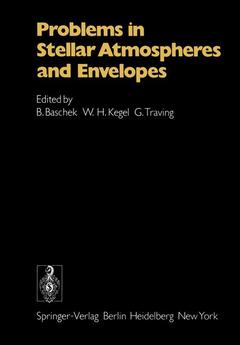Description
Problems in Stellar Atmospheres and Envelopes, Softcover reprint of the original 1st ed. 1975
Coordinators: Baschek B., Kegel W.H., Traving G.
Language: English
Keywords
Problems in Stellar Atmospheres and Envelopes
Publication date: 04-1975
Publication date: 04-1975
Problems in Stellar Atmospheres and Envelopes
Publication date: 01-2012
378 p. · 17x24.4 cm · Paperback
Publication date: 01-2012
378 p. · 17x24.4 cm · Paperback
Contents
/li>
The Energy Flux of the Sun A Critical Discussion of Standard Values for the Solar Irradiance.- 1. Introduction.- 2. High Altitude Experiments.- 3. Discussion of the Results.- 4. Results of Measurements in the Far Ultraviolet.- References.- Model Stellar Atmospheres and Heavy Element Abundances.- 1. Introduction.- 2. The Temperature Stratification.- 3. The Gas and Electron Pressures.- 4. The Energy Distribution in the Continuum.- 4.1. The Balmer Discontinuity.- 4.2. The Ultraviolet Continuum.- 5. The Line Absorption.- 5.1. The Total Line Blanketing.- 5.2. The Metallic Line Absorption.- 5.3. Molecular Lines.- 5.4. The Hydrogen Lines.- 6. The UBV Colors.- 7. The Temperature Calibrations.- 8. The Bolometric Correction.- 9. Convection and Metal Abundances.- 9.1. Convective Instability.- 9.2. Convection Velocities, Microturbulence and Chromospheres.- 9.3. Influence of Convection on the Observed Energy Distribution of Stellar Spectra.- References.- Properties and Problems of Helium Stars.- 1. Introduction.- 1.1. Definitions.- 2. General Properties.- 2.1. List of Objects.- 2.2. Distribution on the Sphere and Velocities.- 2.3. H/He Ratio.- 3. Spectrum.- 3.1. Visual Spectrum.- 3.2. UV-Spectrum.- 4. Atmospheric Structure.- 4.1. Model Atmospheres.- 4.2. Synthetic Spectra and Atmospheric Parameters.- 4.3. Non-LTE Effects.- 5. Individual Obj ects.- 5.1. Extreme Helium Stars.- 5.2. Intermediate Helium Stars.- 5.3. O-Subdwarfs.- 6. Abundances.- 7. Evolution of Model Helium Stars and the (g, Teff) -Diagram.- 7.1. Main Sequences.- 7.2. Evolutionary Tracks.- 7.3. Lifetimes.- 8. Empirical (g, Teff) -Diagram.- 8.1. (g, Teff)-Classification and Masses.- 8.2. Observed Objects.- 9. Variability and Atmospheric Motions.- 10. Conclusion.- References.- Abundance Anomalies in Early-Type Stars.- 1. Introduction.- 2. Problems Related to the Determination of Abundance Anomalies.- 2.1. Definition of Abundances.- 2.2. Relative and Normal Abundances.- 2.3. Model Atmospheres of Peculiar Stars Compared to Normal Stars.- 3. The Population I Peculiar B Stars.- 3.1. The Major Groups of the Ap Stars.- 3.2. The Weak-Helium-Line Stars.- 3.3. Relationship of the Weak-Helium-Line Stars to the Silicon and Manganese Stars.- 3.4. Peculiar Early-B Stars.- 4. The CNO Stars.- 4.1. Properties of the CNO Stars.- 4.2. Element Abundances.- 4.3. Nature of the CNO Anomalies.- 5. The Population II B Stars.- 5.1. Classification.- 5.2. Evolutionary Status.- 5.3. Element Abundances.- 5.4. Discussion of the Abundance Anomalies.- 6. On the Origin of the Ap Phenomenon.- 6.1. Nuclear Processes.- 6.2. Non-Nuclear Processes.- 6.3. Removal of Surface Abundance Anomalies.- 6.4. Inferences from the Early-Type Peculiar Stars.- References.- A-Type Horizontal-Branch Stars.- 1. Introduction.- 2. Characteristics of A-Type Atmospheres.- 3. Observational Quantities.- 4. Field Horizontal-Branch Stars.- 5. Horizontal-Branch Stars in Globular Clusters.- 5.1. NGC 6397.- 5.2. NGC 6121 (M4).- 6. Chemical Composition and Mass-Luminosity Relation.- 6.1. Chemical Composition.- 6.2. Mass-Luminosity Ratio.- References.- White Dwarfs: Composition, Mass Budget and Galactic Evolution.- 1. Introduction.- 2. The Atmospheres of White Dwarfs.- 2.1. White Dwarfs with Hydrogen-Rich Atmospheres.- 2.2. White Dwarfs with Hydrogen-Deficient Atmospheres.- 3. Composition of Interiors and Envelopes. White-Dwarf Formation.- 4. Interpretation of Atmospheric Composition Differences DA vs. Non-DA Stars.- 5. White Dwarfs: Mass Budget and Galactic Evolution.- References.- Herbig-Haro Objects and T Tauri Nebulae.- 1. Introduction.- 2. Observation of Herbig-Haro Obj ects.- 2.1. Occurrence and Apparent Structure.- 2.2. Variability.- 2.3. Reddening and Interstellar (Circumstellar?) Absorption.- 2.4. Spectra.- 2.5. Polarization and Relation of Herbig-Haro Objects to Infrared Sources.- 3. Theory and Theoretical Deductions from the Observations.- 3.1. Direct Interpretation of the Spectra.- 3.2. Theoretical Interpretation of the Observed Ionization and Excitation.- 3.3. Evolutionary Significance of Herbig-Haro Objects.- 4. The T Tauri Emission Nebula.- References.- Circumstellar Envelopes and Mass Loss of Red Giant Stars.- 1. Introduction.- 2. Circumstellar Absorption Lines.- 3. Dust and Molecules in the Circumstellar Envelopes of Red Giants.- 3.1. The Infrared Silicate Excess.- 3.2. Polarization.- 3.3. Microwave Emission from Molecules.- 4. The Dependence of Mass Loss on Basic Stellar Parameters.- 5. Consequences for Stellar Evolution.- References.- Cosmic Masers.- 1. Introduction.- 2. Observational Characteristics.- 2.1. OH Sources.- 2.2. H2O Sources.- 3. Radiative Transfer.- 3.1. General Relations.- 3.2. Unsaturated Masers.- 3.3. Saturation Effects.- 3.4. The Influence of the Infrared Lines.- 3.5. The Influence of Continuous Absorption.- 3.6. Velocity Fields.- 4. Polarization.- 5. Pumping Mechanisms.- 5.1. General Considerations.- 5.2. The OH Molecule.- 5.3. The H2O Molecule.- 6. Models.- 7. Discussion and Conclusion.- References.- Radio Emission from Stellar and Circumstellar Atmospheres.- 1. Introduction.- 2. Stellar Chromospheres and Coronas.- 3. Solar-Type Activity on Stars.- 4. Flare Stars: UV Cet et al.- 5. Radio Emission from Close Binaries.- 6. Radio Emission from Objects with Circumstellar Envelopes.- 7. X-Ray Stars as Radio Emitters.- 8. The Remaining Stellar Observations.- References.- Line Formation in Turbulent Media.- 1. Introduction.- 2. General Structure of the Problem.- 3. Line Formation in Discontinuous Velocity Fields.- 4. Line Formation in Media with Continuous Velocity Fields.- 5. Solution of the Generalized Transfer Equation.- 6. An Approach to NLTE Line Formation in Turbulent Media.- 7. Concluding Remarks.- References.- Index of Astronomical Objects.
© 2024 LAVOISIER S.A.S.




